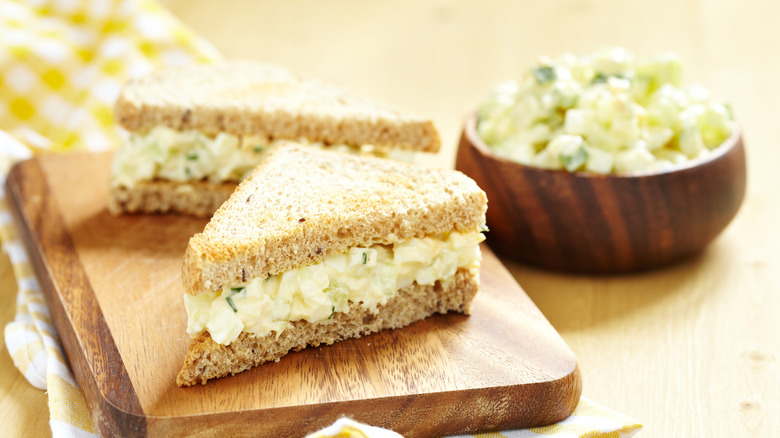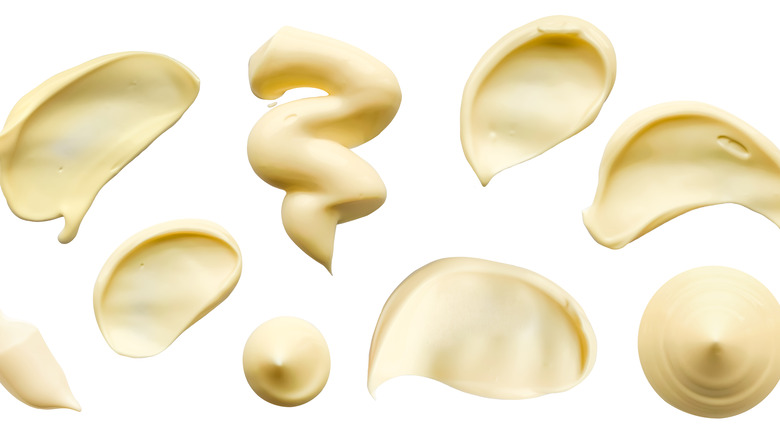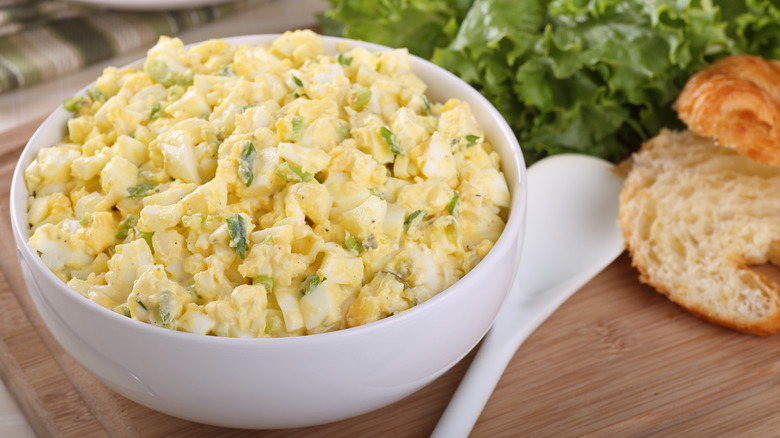The Hazy History Of Egg Salad
Egg salad is one of those dishes of which there is no in-between; you either love it or you most definitely don't. Either it is a delightful concoction of perfectly cooked, unctuous eggs; creamy, rich mayonnaise, and bright, crisp slices of vegetables, such as celery and onion, or it is a gloopy mush that coats the mouth in all the wrong ways and reeks of sulfur.
Like chicken salad, potato salad, and deviled ham, egg salad is classified as a bound salad. As Allrecipes points out, these dishes typically contain hearty ingredients – the aforementioned chicken, potatoes, or ham, as well as crunchy, raw vegetables – "bound" in a heavy dressing, quite often mayonnaise. Bound salads can be used in a number of ways, from a simple salad with greens to a sandwich filling to a satisfying side in the case of potato or macaroni salad. If you've ever been to a posh high tea, you were likely served bound salads in between delicate crust-free slices of white bread, AKA tea sandwiches (via Southern Living).
Eggs and mayonnaise are a match made in heaven. These two ingredients are essential to egg salad. While many other items add to the experience, remove either eggs or mayo and you just no longer have egg salad. In bistros across France, The New Yorker points out, oeuf mayo – literally "eggs mayo" – is a classic, if underrated, stalwart. But the history of egg salad and how its major components came together is hazy.
Mayonnaise begins
Tracing the origins of a composed sauce like mayonnaise should be easy, right? Slate tried to do just that, but found that mayo has ambiguous origins. Historical adversaries in many a continental dust-up, France and Spain, have valid claims on the sauce, At its most basic, it is an emulsion of egg yolks and oil spiked with seasonings and acid. It may have come about around the time of the 1756 French siege of the Spanish island Minorca. The personal chef of the Duke de Richelieu could have whipped up the sauce as a replacement for cream and christened it after the capital, Port Mahon. Or, it might have been the Minorcans who taught the chef how to make the sauce in the first place. Or, it was born in the French town of Bayonne, admittedly close to the Spanish border, and was first called "bayonnaise."
While we don't when people first combined eggs and mayo, it seems reasonable to think it happened before mayonnaise was widely consumed in the U.S. The white sauce that is available in every supermarket and sandwich shop today wasn't very popular in America until the early 1900s, says Food Science & Nutrition. Already known in France and mentioned in British and German cookbooks during the 1800s, mayonnaise was mostly within the purview of wealthy consumers in America until people like German immigrant Richard Hellman began producing a commercial version. He first sold mayonnaise from his deli in 1905 (via NPR).
When did we start eating egg sandwiches?
It's hard to know how long humans have been eating eggs. As the American Egg Board points out, bird eggs predate recorded history. What we do know is that by 3200 B.C., humans in Egypt had domesticated fowl. By 1400 B.C., Chinese texts pointed to the existence of specialized laying fowl, and there may have been some level of avian domestication in the pre-Columbian Americas. But what about one of the main ways egg salad is enjoyed – as a sandwich filling?
While the term "sandwich" is traced to the fourth Earl of Sandwich, John Montagu, and possibly the year 1762 (via History), some version of the food may have been around since the first century B.C. It might be impossible to say who kicked things off with egg sandwiches, but they existed in the 1800s. Food Timeline found that in 1866, "Mrs. Crowen's American Lady's Cookery Book" suggested that cold slices of boiled egg make a suitable filling for light luncheon sandwiches. Boiled eggs also found themselves mixed with chutney, cream, or herring, among other ingredients, in "The 'Queen' Cookery Books No. 9: Salads, Sandwiches, and Savories, Second Edition" of 1905.
Many of us might conflate egg sandwiches with breakfast sandwiches. The Bend Bulletin says that rolls containing eggs, meat, and possibly cheese seemingly popped up on the scene in 19th-century England, where industrial workers in need of a quick, tidy breakfast they could eat on the go. Today, egg-based breakfast sandwiches are a staple of fast food restaurants.
Egg salad by any other name
It can never be known precisely who invented egg salad as we know it today, but The Nibble has done an admirable job tracing its likely origins. The inception point may well be an old English style of composed, layered salad known as salmagundi. The site suggests that someone in Britain may have created the first egg salad sandwich in the 19th century. In the U.S., Rooted In Foods tracked down an early recipe for "egg salad," turning up an 1899 article in a Hamilton, Ohio newspaper that calls for butter rather than mayonnaise. This does run counter to our earlier assertion that mayonnaise is essential to egg salad, but we have to let it slide. In most other regards, this is a recipe for what we know as egg salad. It also calls for chopped chicken breast, so it may well be considered a chicken salad recipe, but we'll side with the source on this one.
Variations, as with all other bound salads, are plentiful. Popular sandwich historian Barry Enderwick (@sandwichesofhistory) featured a 1936 variation – the Shrimpegg sandwich – that calls for shrimp and walnuts in addition to egg and mayonnaise. Perhaps the most innovative take comes from Steven Raichlen whose Israeli Smoked Egg pate bathes boiled eggs in smoke before thoroughly pureeing them with mayonnaise, parsley, and a kiss of lemon juice.



